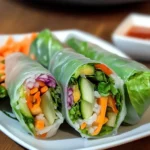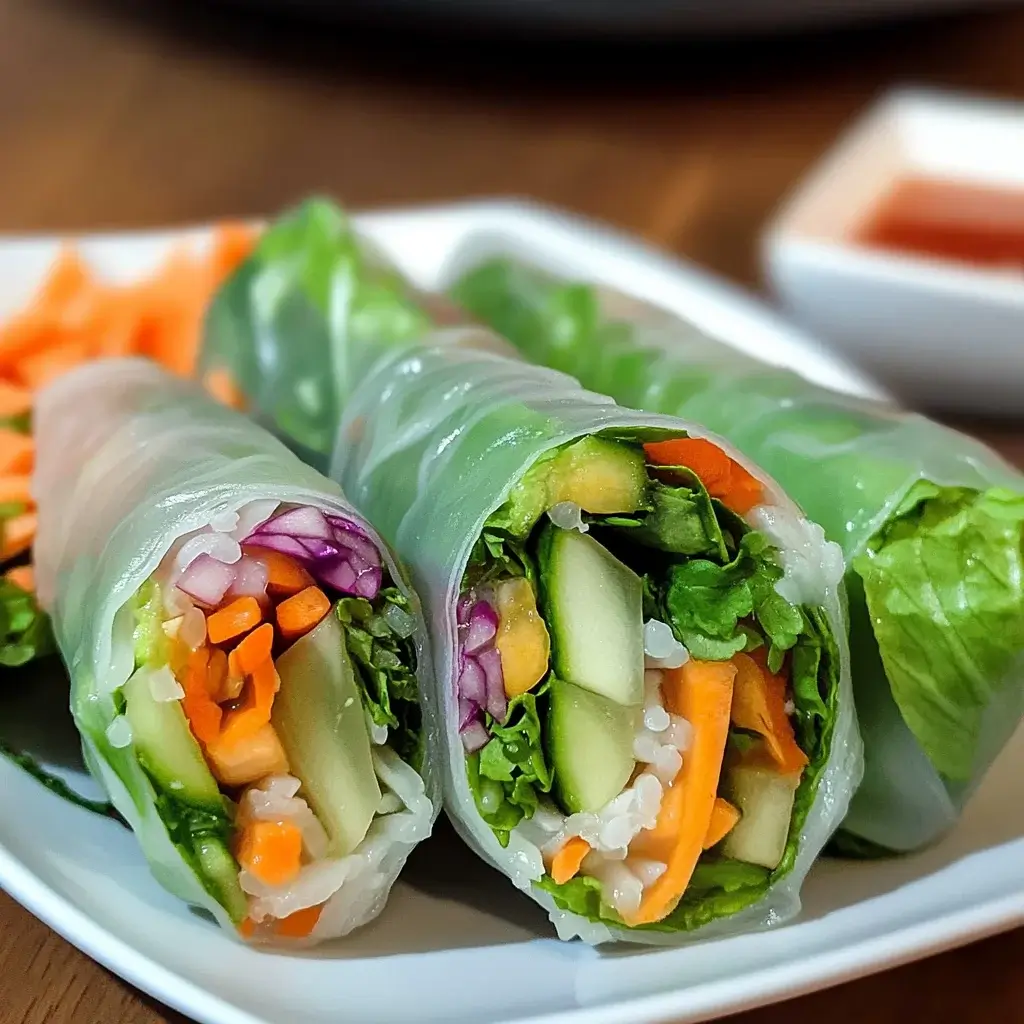It’s funny how some of the simplest recipes can become instant family favorites, isn’t it? That’s exactly what happened with these Veggie-Packed Rice Paper Rolls in our house. I was looking for a light, refreshing, and healthy lunch option that could also use up some of the vegetables wilting slightly in the crisper drawer. Honestly, I wasn’t expecting much more than a “meh, it’s okay” response from my crew. But boy, was I wrong! From the first bite, everyone was hooked. The crisp freshness of the vegetables, the delicate chewiness of the rice paper, and the burst of flavor from the dipping sauce – it was a culinary home run. Even my picky eaters, who usually shy away from anything green, were enthusiastically rolling and dipping. Now, these Veggie-Packed Rice Paper Rolls have become a regular feature on our weekly menu, perfect for light lunches, fun appetizers, or even a light and satisfying dinner. They are incredibly versatile, customizable to whatever vegetables you have on hand, and a genuinely delightful way to eat your veggies. Trust me, give these a try, and you might just find yourself pleasantly surprised too!
Ingredients
- Rice paper wrappers: These delicate, translucent sheets are the foundation of our rolls, providing a light and slightly chewy exterior.
- Carrots: Adds a vibrant orange color, a satisfying crunch, and a subtle sweetness.
- Cucumber: Offers a refreshing coolness and crisp texture, balancing the other flavors.
- Bell Peppers (various colors): Provides a sweet and slightly tangy flavor, along with a satisfying crunch and beautiful color variety.
- Avocado: Lends a creamy richness and healthy fats to the rolls, making them more satisfying.
- Lettuce (Romaine or Butter): Forms a crisp and refreshing base layer inside the rolls, adding bulk and freshness.
- Fresh Mint: Provides a bright, cool, and aromatic lift, essential for that authentic fresh roll flavor.
- Fresh Cilantro: Adds a citrusy and slightly peppery note, complementing the other fresh herbs and vegetables.
- Rice Vermicelli Noodles: These thin, delicate noodles add a light and satisfying carbohydrate element without being heavy.
- Peanut Sauce (for dipping): A creamy, savory, and slightly sweet sauce that perfectly complements the fresh vegetables. (Alternatively, soy sauce based dipping sauce can be used for nut-free options).
- Sesame Seeds (optional): Adds a nutty flavor and a decorative touch when sprinkled on top.
Instructions
- Prepare the Vegetables: Begin by washing all your vegetables thoroughly. Peel the carrots and cucumber. Cut the carrots, cucumber, and bell peppers into thin matchsticks or julienne strips, approximately 2-3 inches long. Avocado should be sliced thinly just before rolling to prevent browning. Wash and dry the lettuce leaves. Pick the mint and cilantro leaves from their stems.
- Cook the Vermicelli Noodles: Cook the rice vermicelli noodles according to the package directions. Usually, this involves soaking them in boiling water for a few minutes until they are tender but still slightly firm. Once cooked, drain the noodles and rinse them under cold water to stop the cooking process and prevent them from sticking together. Set aside.
- Prepare the Dipping Sauce: If you are making your own peanut sauce, whisk together peanut butter, soy sauce (or tamari for gluten-free), rice vinegar, honey or maple syrup (for vegan), a little water to thin, and a dash of sesame oil (optional). Taste and adjust seasonings as needed. If using a store-bought sauce, have it ready in a dipping bowl.
- Set up your Rolling Station: Fill a shallow dish or pie plate with warm water. This will be used to soften the rice paper wrappers. Arrange all your prepared ingredients – vegetables, noodles, herbs, avocado – on a clean work surface or cutting board, making it easy to access them while rolling.
- Soften the Rice Paper: Take one rice paper wrapper and quickly dip it into the warm water, rotating it to ensure it is evenly moistened. Don’t soak it for too long, just a few seconds, as it will continue to soften as you work. Remove the softened rice paper and place it flat on your clean work surface.
- Assemble the Roll: Working quickly while the rice paper is still pliable, place a lettuce leaf near the bottom third of the rice paper wrapper, leaving a border around the edges. On top of the lettuce, arrange a small handful of vermicelli noodles, followed by a selection of your prepared vegetables (carrots, cucumber, bell peppers), avocado slices, mint leaves, and cilantro leaves. Be mindful not to overfill the roll, as it will be harder to close.
- Roll the Rice Paper Roll: To roll, fold the bottom edge of the rice paper wrapper up and over the filling, tucking it in tightly. Then, fold in the sides of the wrapper, like you are folding a burrito. Finally, continue rolling upwards tightly until you reach the top edge, sealing the roll.
- Repeat and Serve: Repeat steps 5-7 with the remaining rice paper wrappers and ingredients until you have used up all the ingredients or have made the desired number of rolls.
- Garnish and Serve: If desired, you can sprinkle sesame seeds on top of the finished rolls for added flavor and visual appeal. Cut the rolls in half diagonally, if preferred, for easier dipping and serving. Serve immediately with the prepared peanut dipping sauce or your choice of dipping sauce.
Nutrition Facts
(Per Serving – approximate, may vary based on ingredients and quantities used)
- Servings: Approximately 6-8 rolls (depending on size)
- Calories per serving (2 rolls): 250-350 kcal (estimate)
- Fat: 10-15g (estimate, depends on avocado and sauce)
(Note: These are estimations. For precise nutritional information, use a nutrition calculator with your specific ingredients and quantities.)
Preparation Time
- Prep Time: 30-40 minutes (chopping vegetables, cooking noodles, preparing sauce)
- Rolling Time: 20-30 minutes (depending on quantity and rolling speed)
- Total Time: 50-70 minutes
(This recipe is relatively quick to prepare, especially if you are efficient at chopping vegetables. Most of the time is spent in preparation and assembly, not cooking. It’s a great recipe for involving others in the kitchen – make it a fun family or friend activity!)
How to Serve
- As a Light Lunch or Dinner: Serve 2-3 rice paper rolls per person for a satisfying and healthy meal. Pair with a side salad or a light soup for a more complete meal.
- As an Appetizer: Cut the rolls in half diagonally and arrange them attractively on a platter. Serve with dipping sauce for a visually appealing and delicious appetizer at parties or gatherings.
- With Different Dipping Sauces: Offer a variety of dipping sauces to cater to different tastes. Consider:
- Peanut Sauce: Classic and creamy.
- Soy Sauce with Ginger and Sesame Oil: A lighter, savory option.
- Sweet Chili Sauce: Adds a touch of sweetness and spice.
- Hoisin Sauce: Rich and slightly sweet, often used in Asian cuisine.
- Spicy Sriracha Mayo: For those who like a kick.
- Cold or at Room Temperature: Rice paper rolls are best served fresh and slightly chilled or at room temperature. They are perfect for picnics, potlucks, or taking to work for lunch.
- Garnished with Toppings: Sprinkle sesame seeds, chopped peanuts, or fresh herbs on top for extra flavor and visual appeal.
Additional Tips
Don’t Oversoak the Rice Paper
One of the most crucial aspects of crafting perfect rice paper rolls lies in the careful soaking of the wrappers. The rice paper needs just a brief dip in warm water—typically around 10 to 15 seconds—until it becomes pliable but still firm enough to handle. Remember that the rice paper will continue to soften as you work with it, so it’s essential not to leave it in the water for too long. Oversoaking can lead to wrappers that are overly sticky and difficult to manipulate, making rolling nearly impossible. If you find that your rice paper is too sticky, it may tear when you attempt to roll it, spoiling your beautifully prepared ingredients.
Prepare Ingredients in Advance
Efficiency is key when it comes to making rice paper rolls. To streamline the rolling process, it’s highly recommended to prepare all your fillings and dipping sauces ahead of time. This preparation includes washing, chopping, and organizing your vegetables, cooking and cooling your noodles, and mixing your dipping sauce. By having everything laid out and ready to go, you can focus on the rolling technique rather than scrambling to find ingredients. This not only makes the process faster but also transforms it into a more enjoyable experience, allowing you to savor the art of assembling your rolls without the stress of last-minute preparations.
Get Creative with Fillings
Rice paper rolls are incredibly versatile and lend themselves well to a wide variety of fillings. While traditional ingredients such as shrimp, avocado, and vermicelli noodles are popular, don’t hesitate to get creative based on your taste preferences and seasonal produce. Consider adding crunchy bean sprouts for texture, shredded cabbage for extra crunch, or julienned jicama for a refreshing bite. Edamame can add a protein punch, while marinated tofu offers a rich flavor that pairs well with fresh herbs. Grilled vegetables, such as bell peppers, zucchini, or eggplant (cooled after grilling), can also enhance the taste and visual appeal of your rolls. The possibilities are endless, so let your imagination and seasonal availability guide you.
Use Warm (Not Hot) Water
When it comes to softening rice paper, the temperature of your water matters significantly. Warm water, ideally at a temperature that feels comfortable to the touch (around 100°F to 110°F), is perfect for this task. Hot water, on the other hand, can cause the wrappers to become overly sticky, making them prone to tearing and difficult to work with. If you find your water is too hot, allow it to cool slightly before dipping the rice paper. A gentle approach will help maintain the integrity of the wrappers while ensuring they are pliable enough for rolling.
Work on a Damp Surface
To facilitate the rolling process and prevent the rice paper from sticking to your workspace, consider working on a slightly damp cutting board or surface. You can achieve this by lightly spritzing the surface with water or placing a damp paper towel underneath your cutting board. This minor adjustment can make a significant difference, allowing your rice paper to glide smoothly as you roll, thereby reducing the risk of tearing or sticking.
Roll Tightly but Gently
The technique of rolling your rice paper rolls is essential for achieving the perfect shape and ensuring their structural integrity. Aim to roll the wrappers tightly enough to hold the fillings securely, yet gently enough to prevent tearing. Start by folding in the sides of the rice paper, then bring the bottom edge up to cover the filling, and continue rolling until you reach the top edge. Practice makes perfect, and with each roll, you’ll develop a better sense of how tightly you can roll without damaging the delicate wrappers.
Prevent Sticking
If you’re preparing a large batch of rice paper rolls for a gathering or meal prep, preventing them from sticking together is vital. A simple but effective method is to place a damp paper towel between layers of rolls. This will help keep them moist and separate, allowing for easy serving later. If you’re storing them in an airtight container, ensure there’s enough space to avoid crushing them, which can also lead to sticking.
Make Ahead (with Caution)
While rice paper rolls are undeniably best enjoyed fresh, you can prepare them a few hours in advance if needed. To do this successfully, wrap each roll individually in damp paper towels, which will help maintain moisture and prevent drying out. Store them in an airtight container in the refrigerator to keep them fresh. However, be cautious with the types and amounts of fillings you use; avoid overly wet or juicy ingredients, as these can cause the rice paper to become soggy over time. Ideally, consume the rolls within a few hours of preparation to enjoy the best texture and flavor.
By following these additional tips, you will elevate your rice paper roll-making skills, ensuring a delightful experience both in preparation and tasting. Whether you’re crafting them for a casual meal or a special occasion, these rolls are sure to impress with their fresh flavors and appealing presentation. Enjoy the process and happy rolling!
FAQ
Q1: Can I make these rice paper rolls vegan?
A: Absolutely! This recipe is naturally vegetarian and easily made vegan. Just ensure your dipping sauce is vegan-friendly. Many peanut sauces are already vegan, but check the ingredients to be sure. You can also use a soy sauce-based dipping sauce or a vegan hoisin sauce.
Q2: Are rice paper rolls gluten-free?
A: Yes, rice paper wrappers are typically made from rice flour, tapioca flour, and water, making them naturally gluten-free. However, always double-check the ingredient list on the packaging to confirm, especially if you have severe gluten sensitivities. Also, ensure your dipping sauce is gluten-free (use tamari instead of soy sauce if needed).
Q3: Can I use different types of noodles?
A: Yes, you can substitute the rice vermicelli noodles with other types of noodles. Glass noodles (bean thread noodles) or even thin rice noodles would work well. Just make sure to cook them according to package directions until tender.
Q4: What if I don’t like peanut sauce? What other dipping sauces can I use?
A: There are many delicious dipping sauce alternatives! Soy sauce with grated ginger and sesame oil is a classic choice. Sweet chili sauce, hoisin sauce, or even a spicy sriracha mayo are also great options. Experiment to find your favorite!
Q5: Can I add protein to these rice paper rolls?
A: Yes, you can definitely add protein to make them more substantial. Firm tofu (pan-fried or baked), edamame, or even cooked shrimp (if you are not strictly vegetarian) are great additions. Just ensure any protein you add is cooked and cooled before rolling.
Q6: How do I store leftover rice paper rolls?
A: Rice paper rolls are best eaten fresh. However, if you have leftovers, wrap each roll individually in a damp paper towel and store them in an airtight container in the refrigerator for up to a day. The rice paper might dry out slightly, but they should still be enjoyable.
Q7: My rice paper wrappers keep tearing. What am I doing wrong?
A: Tearing is often caused by either oversoaking the rice paper or being too rough when handling them. Make sure you are only dipping the wrappers briefly in warm water – just until softened. Also, handle them gently and avoid overfilling the rolls, which can put too much stress on the wrapper.
Q8: Can I freeze rice paper rolls?
A: Freezing rice paper rolls is not recommended. The rice paper texture changes significantly upon thawing, becoming mushy and unpleasant. It’s best to enjoy them fresh or within a few hours of making them.

Veggie-Packed Rice Paper Rolls
Ingredients
- Rice paper wrappers: These delicate, translucent sheets are the foundation of our rolls, providing a light and slightly chewy exterior.
- Carrots: Adds a vibrant orange color, a satisfying crunch, and a subtle sweetness.
- Cucumber: Offers a refreshing coolness and crisp texture, balancing the other flavors.
- Bell Peppers (various colors): Provides a sweet and slightly tangy flavor, along with a satisfying crunch and beautiful color variety.
- Avocado: Lends a creamy richness and healthy fats to the rolls, making them more satisfying.
- Lettuce (Romaine or Butter): Forms a crisp and refreshing base layer inside the rolls, adding bulk and freshness.
- Fresh Mint: Provides a bright, cool, and aromatic lift, essential for that authentic fresh roll flavor.
- Fresh Cilantro: Adds a citrusy and slightly peppery note, complementing the other fresh herbs and vegetables.
- Rice Vermicelli Noodles: These thin, delicate noodles add a light and satisfying carbohydrate element without being heavy.
- Peanut Sauce (for dipping): A creamy, savory, and slightly sweet sauce that perfectly complements the fresh vegetables. (Alternatively, soy sauce based dipping sauce can be used for nut-free options).
- Sesame Seeds (optional): Adds a nutty flavor and a decorative touch when sprinkled on top.
Instructions
- Prepare the Vegetables: Begin by washing all your vegetables thoroughly. Peel the carrots and cucumber. Cut the carrots, cucumber, and bell peppers into thin matchsticks or julienne strips, approximately 2-3 inches long. Avocado should be sliced thinly just before rolling to prevent browning. Wash and dry the lettuce leaves. Pick the mint and cilantro leaves from their stems.
- Cook the Vermicelli Noodles: Cook the rice vermicelli noodles according to the package directions. Usually, this involves soaking them in boiling water for a few minutes until they are tender but still slightly firm. Once cooked, drain the noodles and rinse them under cold water to stop the cooking process and prevent them from sticking together. Set aside.
- Prepare the Dipping Sauce: If you are making your own peanut sauce, whisk together peanut butter, soy sauce (or tamari for gluten-free), rice vinegar, honey or maple syrup (for vegan), a little water to thin, and a dash of sesame oil (optional). Taste and adjust seasonings as needed. If using a store-bought sauce, have it ready in a dipping bowl.
- Set up your Rolling Station: Fill a shallow dish or pie plate with warm water. This will be used to soften the rice paper wrappers. Arrange all your prepared ingredients – vegetables, noodles, herbs, avocado – on a clean work surface or cutting board, making it easy to access them while rolling.
- Soften the Rice Paper: Take one rice paper wrapper and quickly dip it into the warm water, rotating it to ensure it is evenly moistened. Don’t soak it for too long, just a few seconds, as it will continue to soften as you work. Remove the softened rice paper and place it flat on your clean work surface.
- Assemble the Roll: Working quickly while the rice paper is still pliable, place a lettuce leaf near the bottom third of the rice paper wrapper, leaving a border around the edges. On top of the lettuce, arrange a small handful of vermicelli noodles, followed by a selection of your prepared vegetables (carrots, cucumber, bell peppers), avocado slices, mint leaves, and cilantro leaves. Be mindful not to overfill the roll, as it will be harder to close.
- Roll the Rice Paper Roll: To roll, fold the bottom edge of the rice paper wrapper up and over the filling, tucking it in tightly. Then, fold in the sides of the wrapper, like you are folding a burrito. Finally, continue rolling upwards tightly until you reach the top edge, sealing the roll.
- Repeat and Serve: Repeat steps 5-7 with the remaining rice paper wrappers and ingredients until you have used up all the ingredients or have made the desired number of rolls.
- Garnish and Serve: If desired, you can sprinkle sesame seeds on top of the finished rolls for added flavor and visual appeal. Cut the rolls in half diagonally, if preferred, for easier dipping and serving. Serve immediately with the prepared peanut dipping sauce or your choice of dipping sauce.
Nutrition
- Serving Size: one normal portion
- Calories: 350
- Fat: 15g






